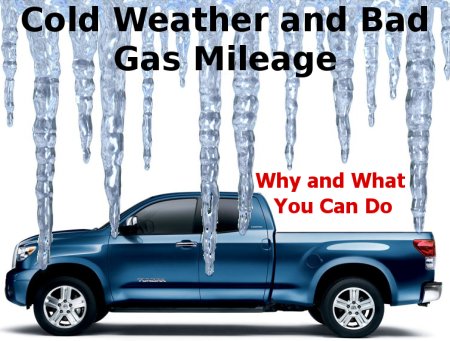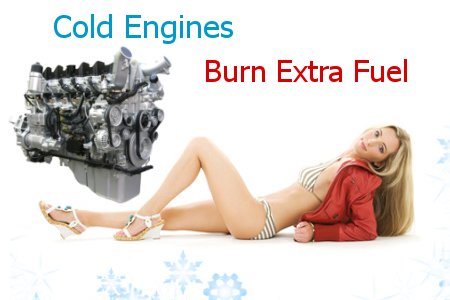Why Cold Weather Hurts Your Truck’s Gas Mileage
Jason Lancaster | Oct 21, 2009 | Comments 18
It’s that time of year again – colder temperatures are coming. During the winter time, most truck owners notice a 5-10% drop in fuel economy. Since truck fuel economy is already pretty low, going from 16 MPG to a little better than 14 MPG means an extra $25 to $50 in extra gas every month…and most truck owners notice that right away.

Why your truck gets bad mileage in the winter and what you can do about it.
It’s frustrating, but it’s something most truck owners have learned to live with. However – there are some things you can do about lower gas mileage in cold weather. First, though, we have to know why it happens.
The most common explanation you’ll hear for the drop in gas mileage is that it’s caused by a “winter blend” of gasoline. While there is a slightly different formula of gasoline sold during the colder months, that’s not the problem. The answer is the cold itself.
Within 30 seconds of starting your truck, the engine computer begins checking the temperature of the air entering the engine. This measurement is important because it determines if extra fuel is needed to prevent a lean condition. [For those that don’t know, “lean” refers to a situation when there isn’t enough fuel being used in the combustion process. Without getting too technical, a “lean” condition is bad because it can cause engine damage.]
The intake air temperature has a direct impact on whether or not an engine will run lean. If the air is very cold, it doesn’t mix properly with gasoline (gasoline atomizes poorly in cold air). Therefore, if your truck’s computer detects cold air, it injects too much fuel (called a “rich” condition) to prevent any possibility of your engine running lean.
Once the engine has reached full operating temperature, the air in the intake is significantly warmed by the heat radiating from the engine compartment. At this point, the engine computer returns to normal and stops using extra fuel. So, the sooner you can warm-up your engine, the better your fuel economy will be in the winter time.

Shelly says cold engines burn extra fuel.
Here’s what you can do to get your cold weather fuel economy back to normal:
1. The easiest solution is to park your vehicle in a heated garage. If you can prevent your engine from getting really cold, you will decrease the amount of time it takes the engine to get nice and hot.
2. Use a block heater, especially in colder climates. Block heaters aren’t technically necessary in most climates in the continental United States, but anyone who has used one will tell you they cut engine warm-up time substantially.
3. Don’t sit and warm-up – start driving right away. When it’s really cold outside, a lot of vehicle owners let their engines run for a few minutes before taking off. However, this “warm-up” really hurts your gas mileage. It’s also bad for the environment, and contrary to popular belief it’s not “good” for your vehicle either.
Bottom Line: Even if you can’t park inside or use a block heater, eliminating extended “warm-up” idling will make a BIG difference in your gasoline bill.
Filed Under: Maintenance Tips


I live in a Sub tropical Climate so i don’t understand about the cold weather stuff……..is the drop dead gorgeous blond a Block Heater? If So, can I get one aftermarket? Do I have to live in a cold climate to use that type of block heater? Whew!…it is getting warm in here. I am going to go open some windows.
I use #1 and #3 to my advantage. Yes you lose pretty good mpg in the cold. You know how hard it is to try and maintain 20mpg? I get from 20 – 24mpg during the summer but winter I’m lucky to keep it in the 20mpg area. That means no punching the pedal at all to keep that. Yes no fun too.
Even living in TX, I experience mornings where there is a layer of ice on my windshield and typically have warmed up my vehicles thinking it was better for the engine, especially the truck since it is not garaged. In California, I’ve already seen a significant drop in my fuel efficiency last week and the temperatures are not much cooler in the past month. My SUV is also experiencing a noticeable drop and it is currrently being driven in Texas. I will be monitoring this change in fuel consumption more closely over the next few months. I am more concerned there really is an issue with the blend being used and not the issue of getting the engine warmer in a shorter period of time to “kick-start” the computer.
Yah, you don’t need your engine sitting idle for 10 minutes rumbling like my Harley neighbor does before he finally decides to take off and rumble and bumble down the road just a chugging along. The Tundra is not a Harley – thank god!
you can get one of those billet grilles they warm the engine up faster too
I don’t think Shelly is going to do much for warming up my truck’s engine, but she sure warm’s MY engine!
But i could swear ive read somewhere in my toyota’s (08 PreRunner Tacoma) manual not to “race” the engine when it is not fully warmed up…correct me if im wrong, but does that refer to revving kind of high? (like say 3,500RPM+)
So like here in houston,tx we’ve had a few somewhat cold mornings, and i try to keep my RPM low, usually below 2,500.
Jr – You are correct. However, there’s a big difference between a jackrabbit start on a cold motor and normal driving. I’m not saying you should be slamming on the pedals, but you don’t have to baby it either. Once the engine is running and the oil is pumping (the first 5 seconds or so), the engine is ready. The main reason to avoid racing the motor is that it’s not good to rev a motor until it’s reached normal operating temperature.
I’ve got an 07′ Tundra, and I was wanting to change out sparkplugs to a better after market kind, if there is any. Any suggestions?
Bobby – There was a particularly bad comment about a popular after-market spark plug forwarded to us about a year ago – https://www.tundraheadquarters.com/blog/2008/02/11/tundra-owners-beware-after-market-spark-plugs/. This story might be a one-off incident, but there are comments from people with similar experiences. My suggestion (for a few reasons) is to stick with the factory plugs. Check out the link for more info.
Whoa, well thanks for the heads up, never heard about that happening but I’ll probably stay with the stock plugs.
I’m convinced something is going on with the gas blend itself. My motorcycle is burning gas at a more significantly high rate as well. The truck has moved once in the past 3 weeks so I can’t test the theory on the engine much right now.
Bobby – np
TXTee – The gas blend is only slightly different, but it could impact some engines more than others I suppose.
are the k&n filter for toyota tundra in tropical countries bring damage to the machine
miquek – Yes. The only issue with a K&N filter in high humidity areas is that they need to be cleaned a little more often…but they’re VASTLY superior to the paper filters in this type of climate.
yeah his #3 rule works if your not in alaska where its negative 20 u start driving ur vehicle with all your fluids froze
AK – Fair enough.
If your fluids are frozen do not start your engine! Plug in the block heater or you will be rebuilding something very quickly. Most new cars with 5w30 will be okay down to -25c. Nothing wrong with idleing up the heat for up to 5 min to defrost windows. Much less carbon clearing the windshield than having to repair bent metal or broken bones in an accident.